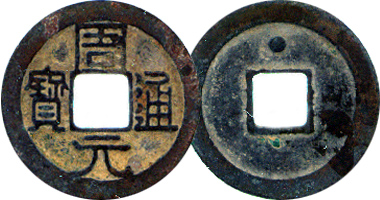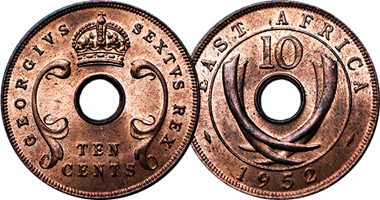Coins With Holes
Holed coins are less rare than one would think, and coins from the countries of China, Korea, Japan, and Vietnam were mostly made with holes in them until the late 1800’s. Most of these coins had square holes, and this was due to the production process.
The coins would be cast on moulds, with a square hole in the middle. Part of the process was to place a square rod through as many as 1000 of the rough coins so that they could be filed to a consistent shape in large batches. Such coins were first created by the Zhou dynasty in China around 500BC. One side would be inscribed with four Chinese characters stating the value of the coin. This tradition ended in 621 AD when the Tang dynasty replaced the inscription with one that referred to the beginning of the dynasty. Since then most coins have had either dynastic or date inscriptions on them.

Well preserved example of an ancient Chinese coin with holes
Such a design had the added advantage that coins were easily kept strung together, rather than carried loose in purses or pockets. Denominations of coins across the East Asian region were standard as well as the design. One wen in Chinese, was one mon in Japanese, for example – and their collection on strings of 100, 300, or 1000 coins served a similar purpose as today’s coin rolls or coin bags, making counting far easier.
These coins are commonly referred to as cash coins, and can still be found in large quantities. Because of this, they tend to have modest sale values of up to $200 or $300.
The coins of East Asia are not the only ones found with holes in. From the mid-1800’s to the mid-1900’s Great Britain issued holed coins for its territories in East Africa. The coinage of the countries today known as Kenya, Tanzania, Uganda, and Somalia, were all marked East Africa, and minted in mostly copper-nickel or bronze. Most of these are worth very little, unless they are in uncirculated condition. One of the most valuable is the 1906 10 Cent coin inscribed with the legend ‘East Africa &Uganda Protectorates’, which in very good condition could be worth as much as $3000.

British holed coin with “East Africa” inscription
Of course, there are other coins that have been holed on purpose other than by the Minting process. Whilst the value of these tend to be minimal – damage, deliberate or otherwise, will always hurt the value of a coin – such coins usually have a story to tell.
Those with holes near their edge will commonly have been used as charms, or bracelets, or, perhaps where the hole is a little larger, as watch fobs.
In America, coins were used for a period as washers for slate roofs. Buildings materials suppliers tried to push the price of washers up from a quarter of a cent each to over 2 cents, so builders started to drill large holes in pennies and use them instead.
In India, jagged holes were often punched into coins and pieces of knotted string inserted for them to be used as buttons on leather clothes, whilst in the USA, before the Civil War, such holed coins were given by suitors to their belles as ‘sweetheart tokens’.
During times of war, coins were often drilled and given to those that were not in favour with the donor: so called ‘hate money’.
Perhaps one of the most enduring reasons for punching holes in coins was started by the Roman Emperor Vespasian (around 79AD), who would give such coins to the sick at what was called a ‘Touching Ceremony’. This tradition carried through many centuries in England, when ‘touching money’ would be given to the sick, or as lucky charms.
A collector who has the good fortune to hold coins with holes in may have the luck to have something of real monetary value in his possession. Or, maybe equally lucky, a piece of history to which he could only guess at the story behind it.

